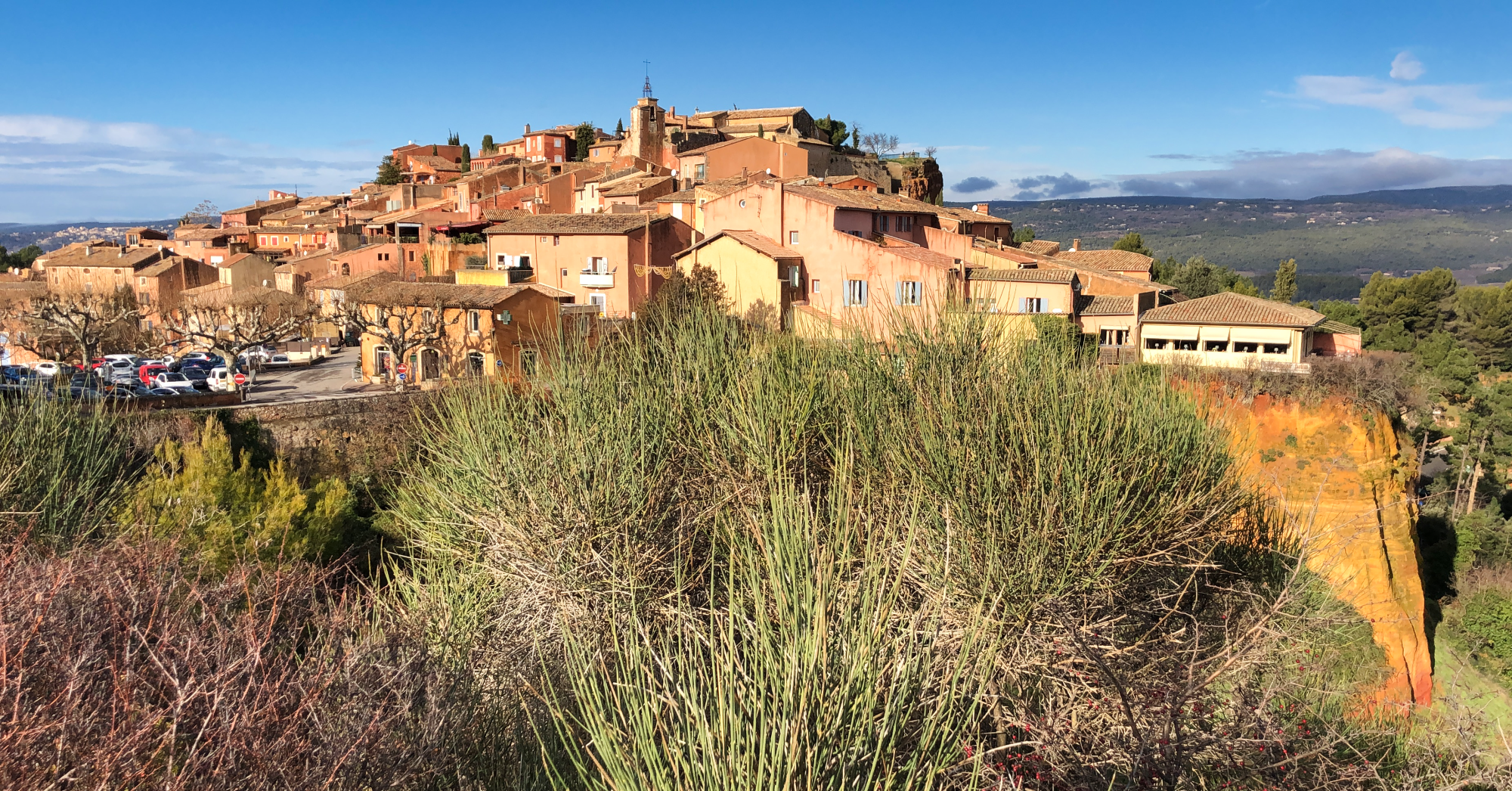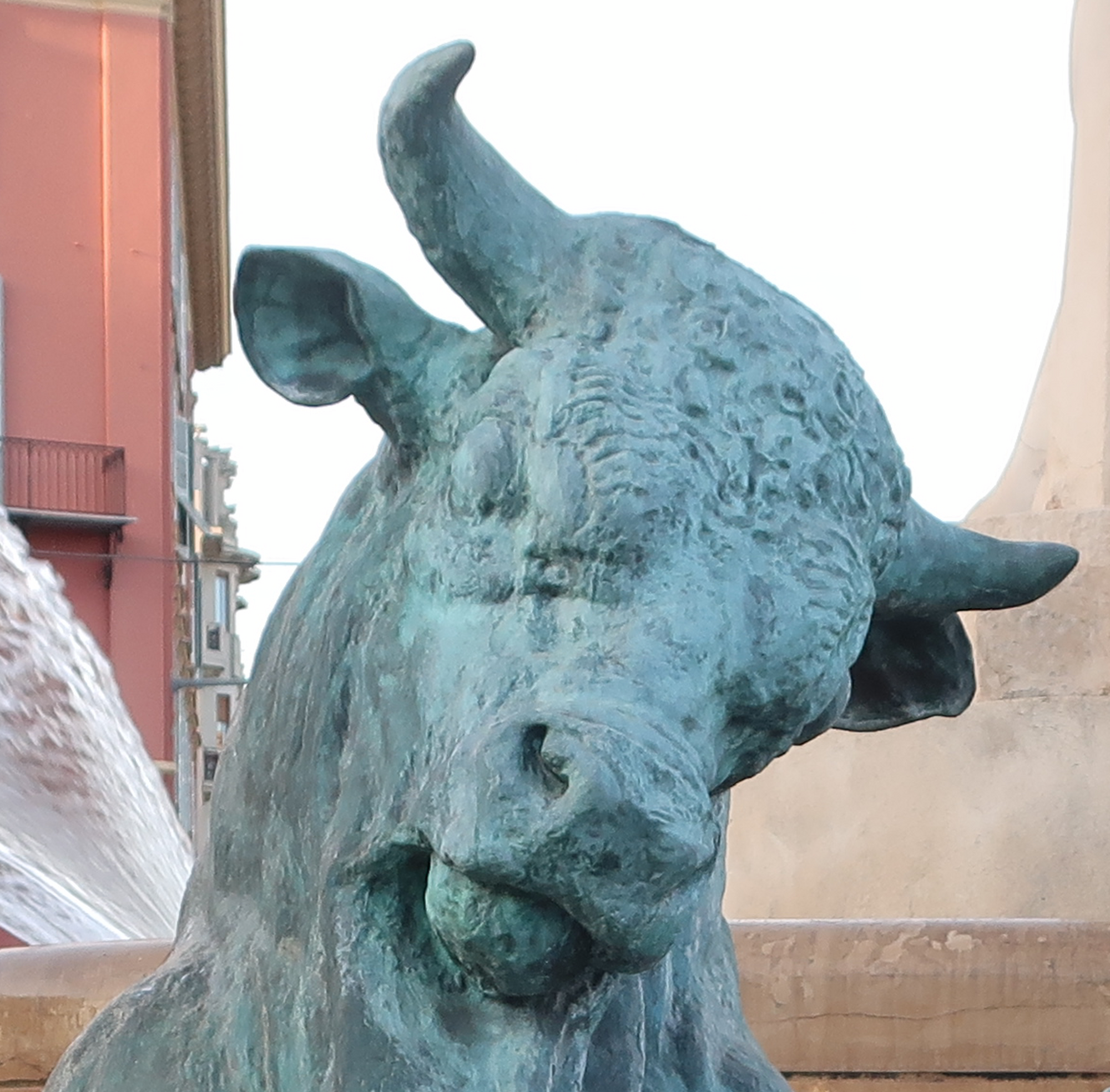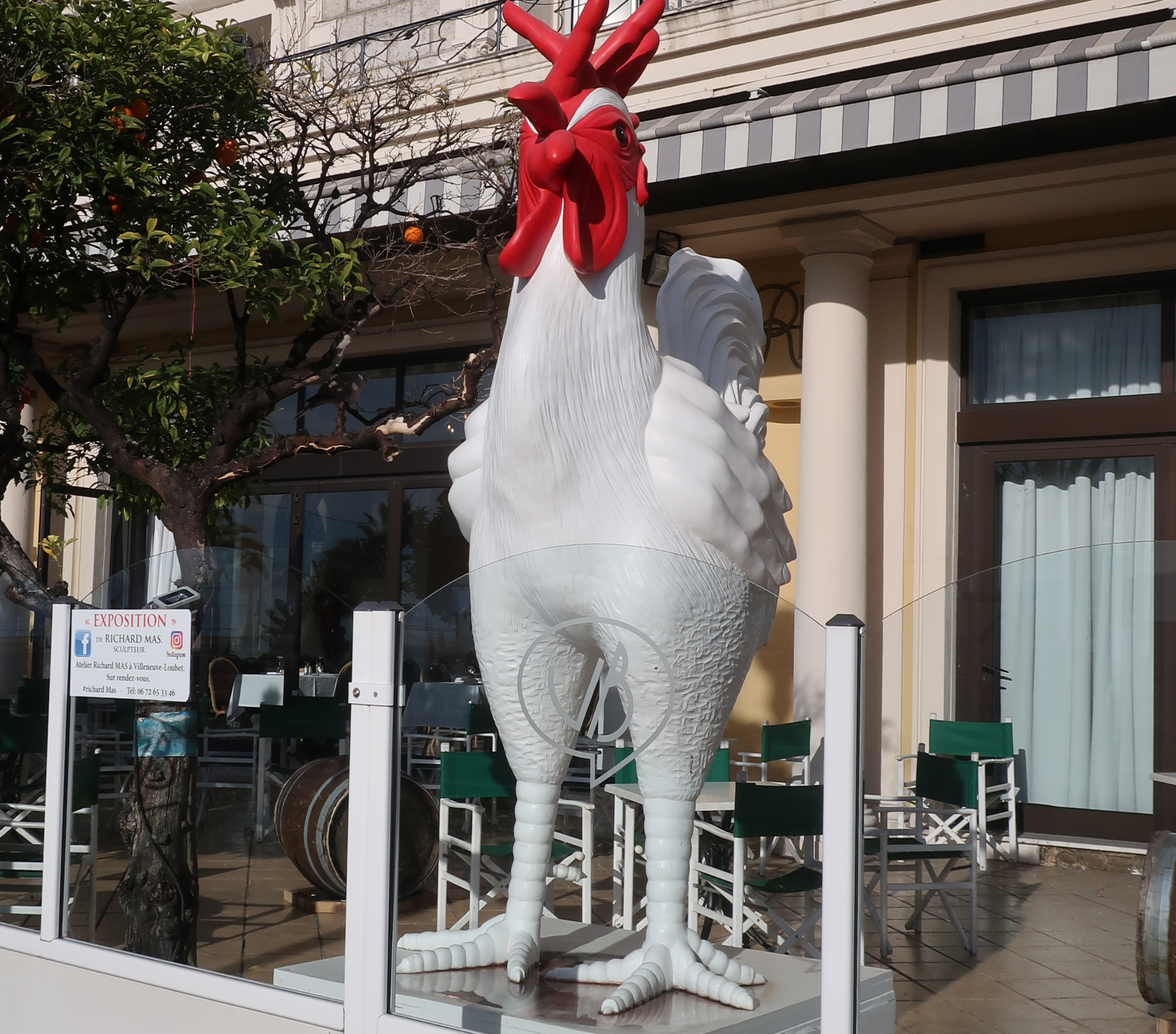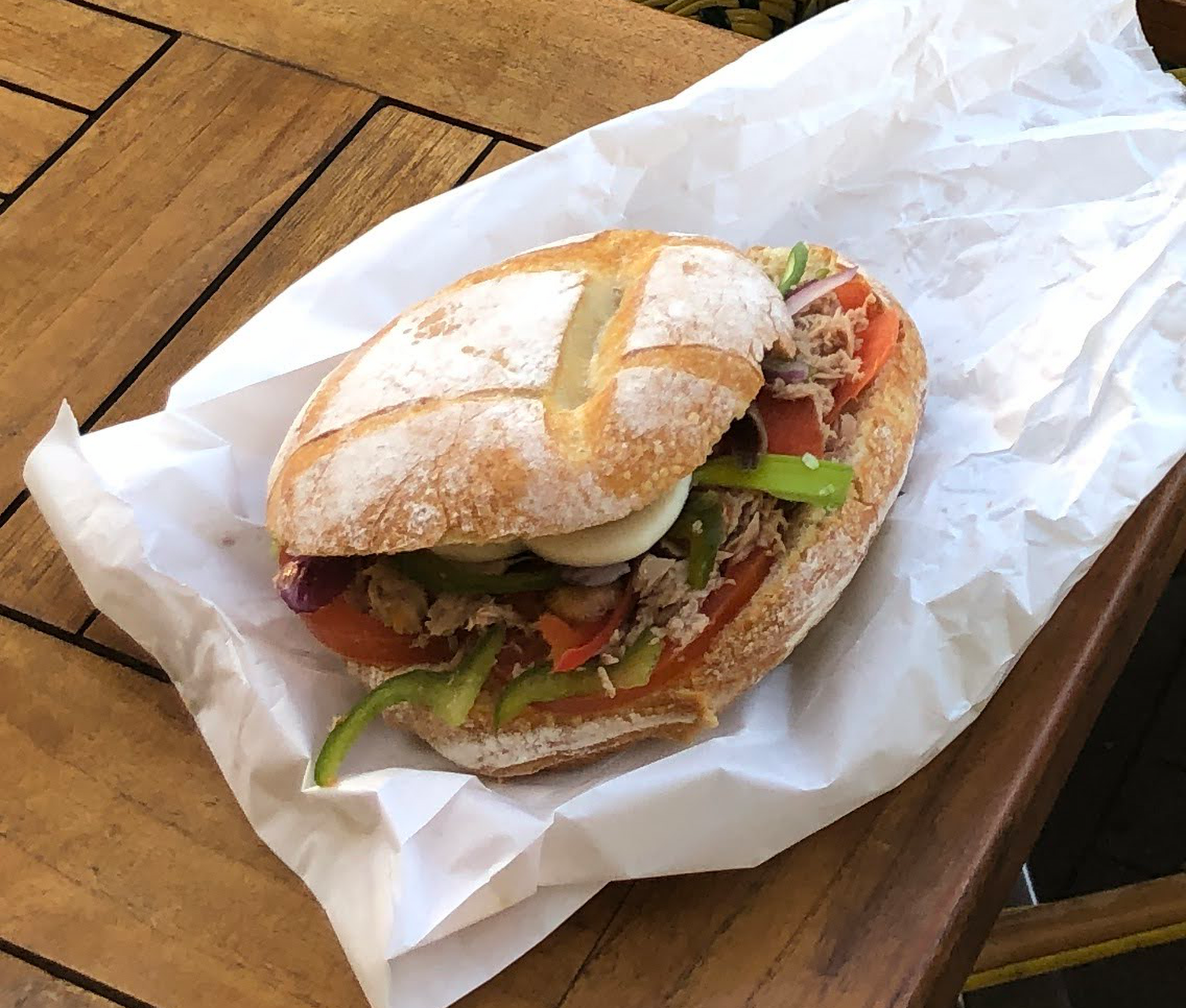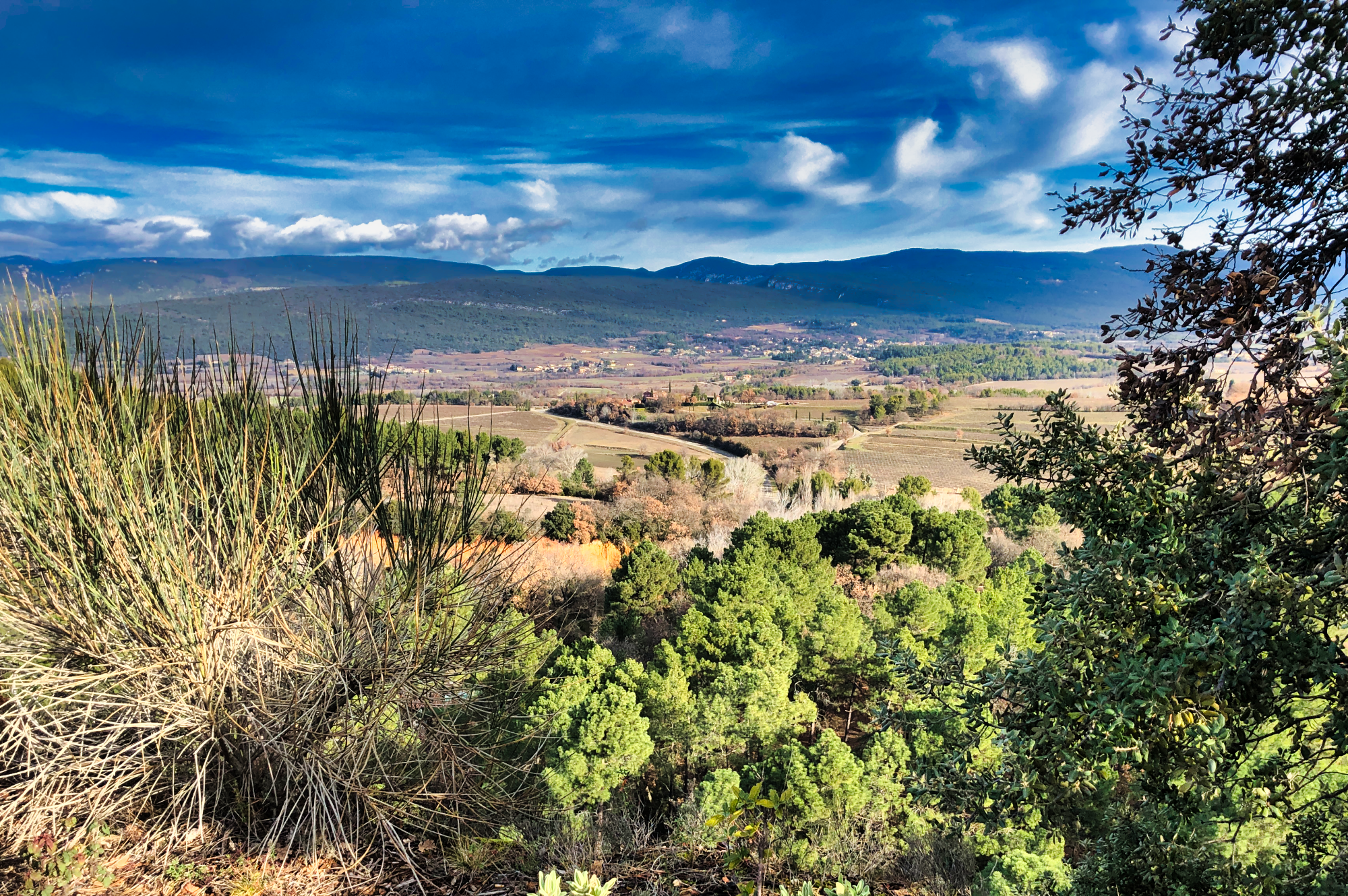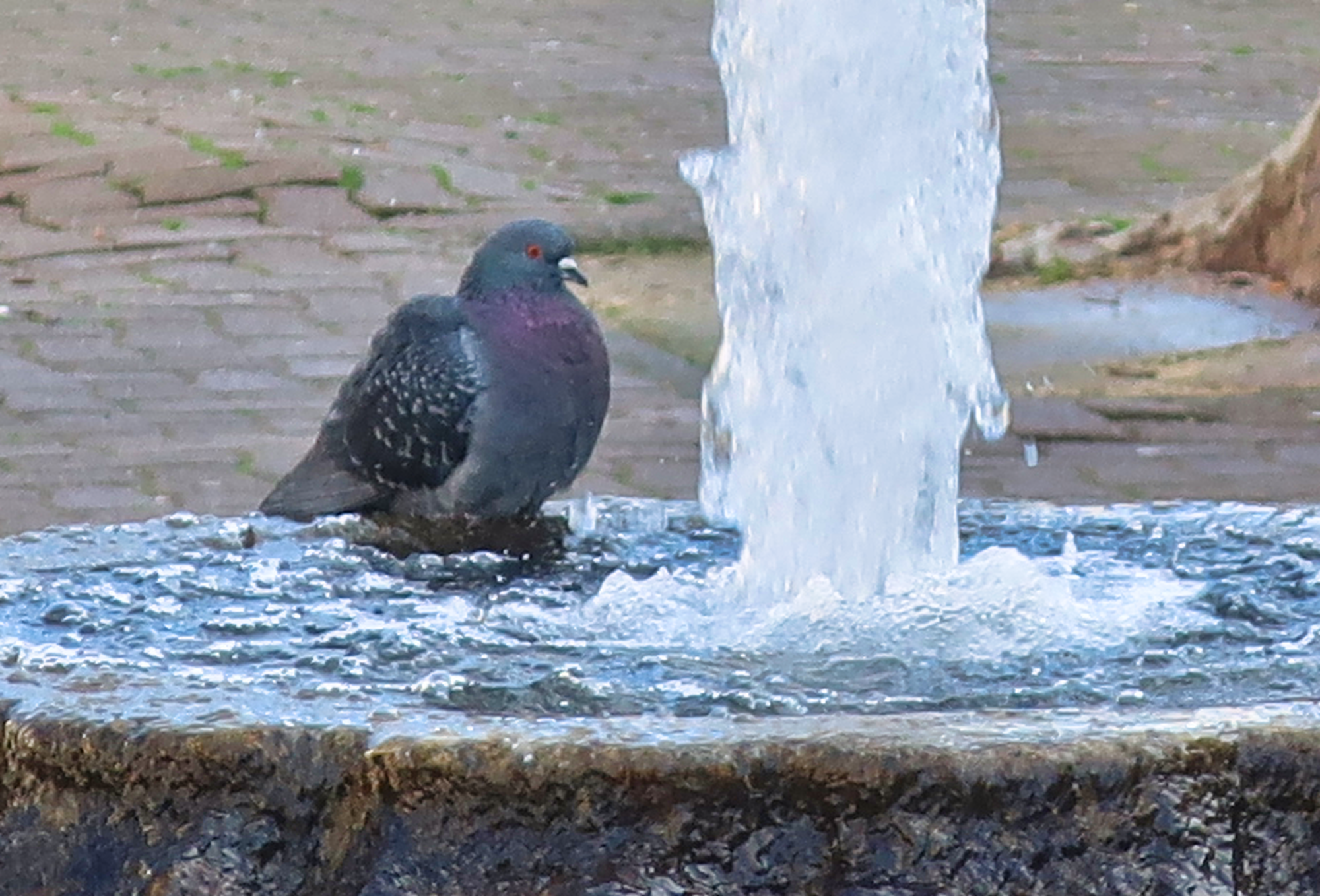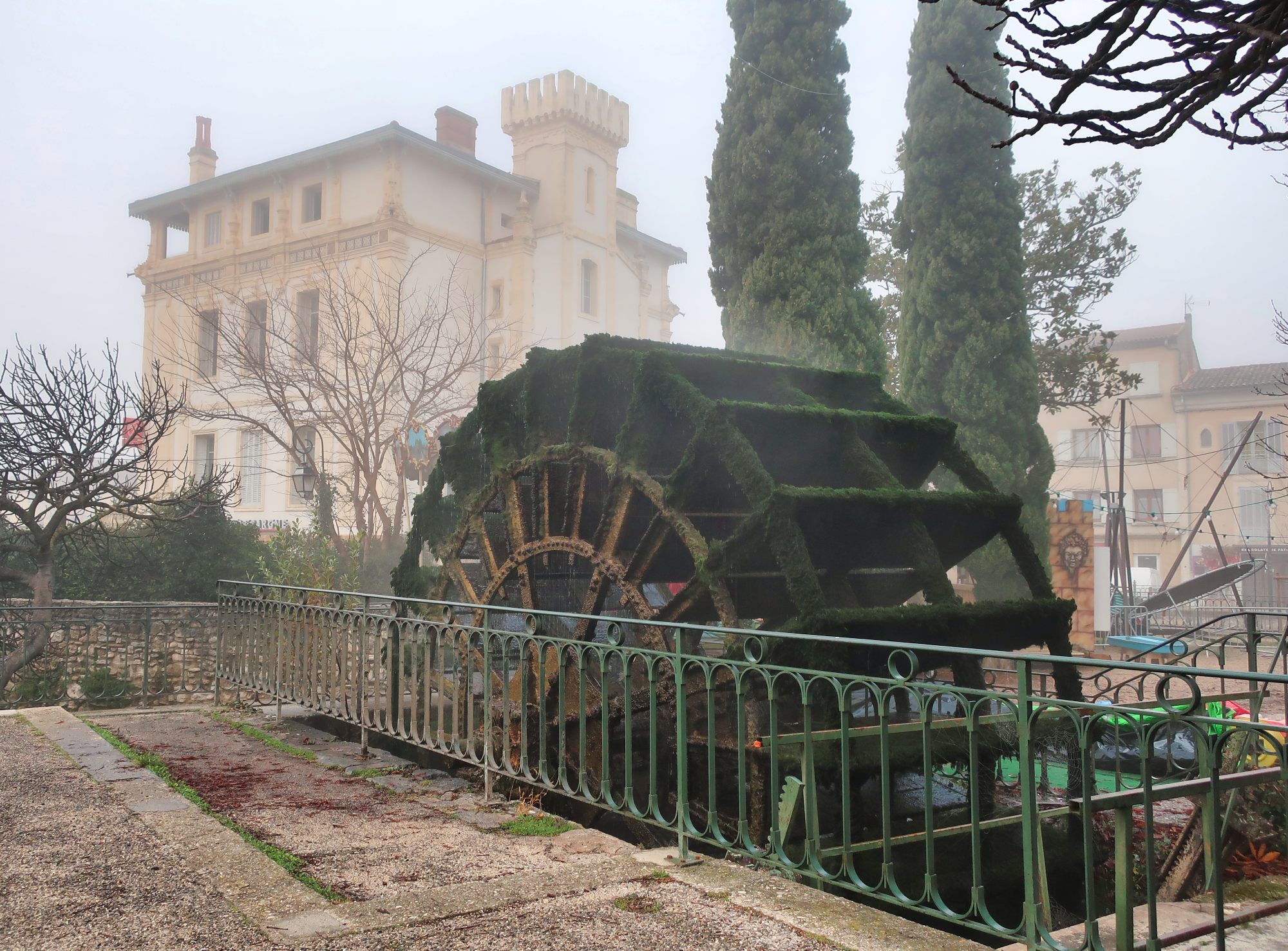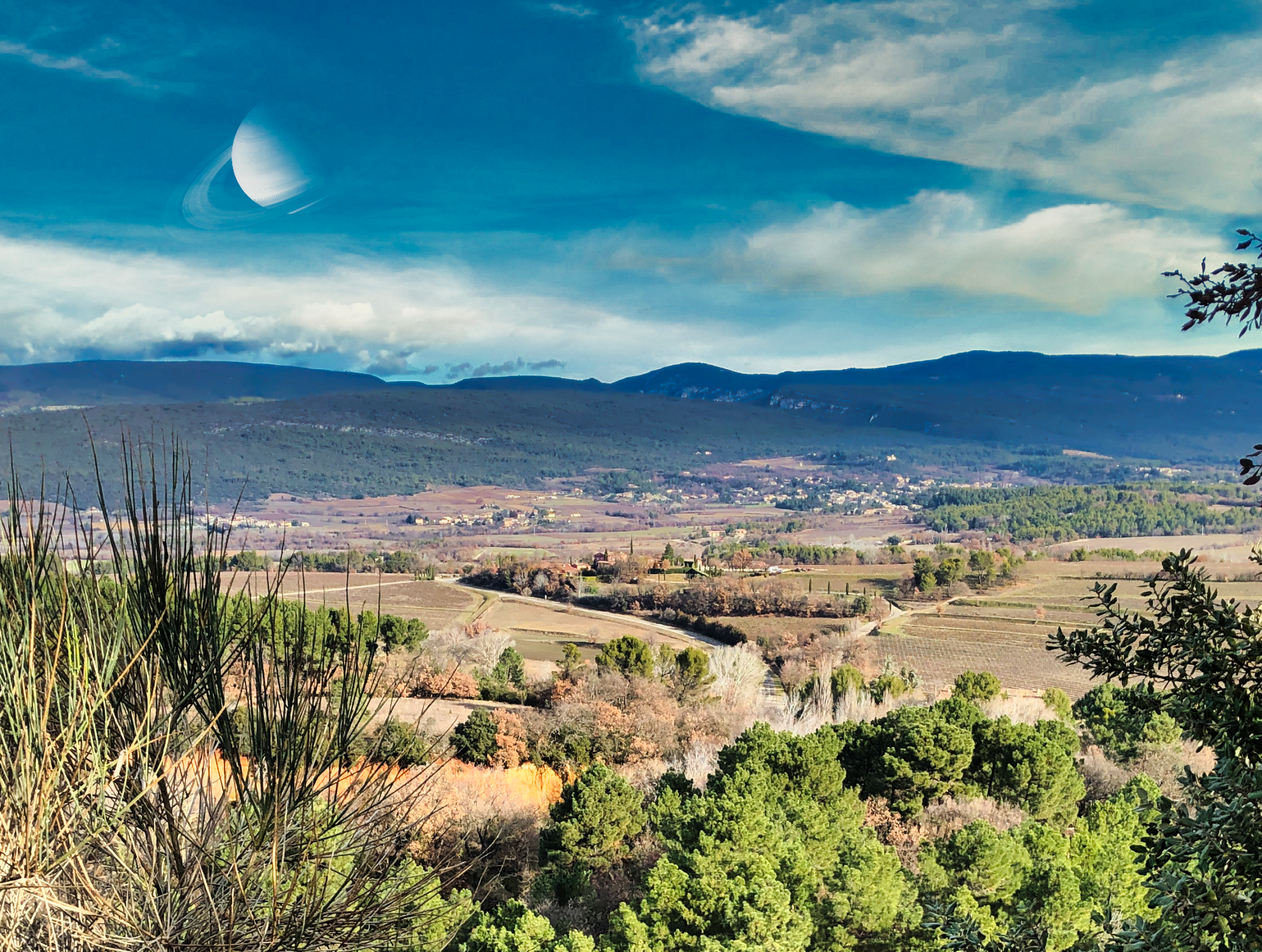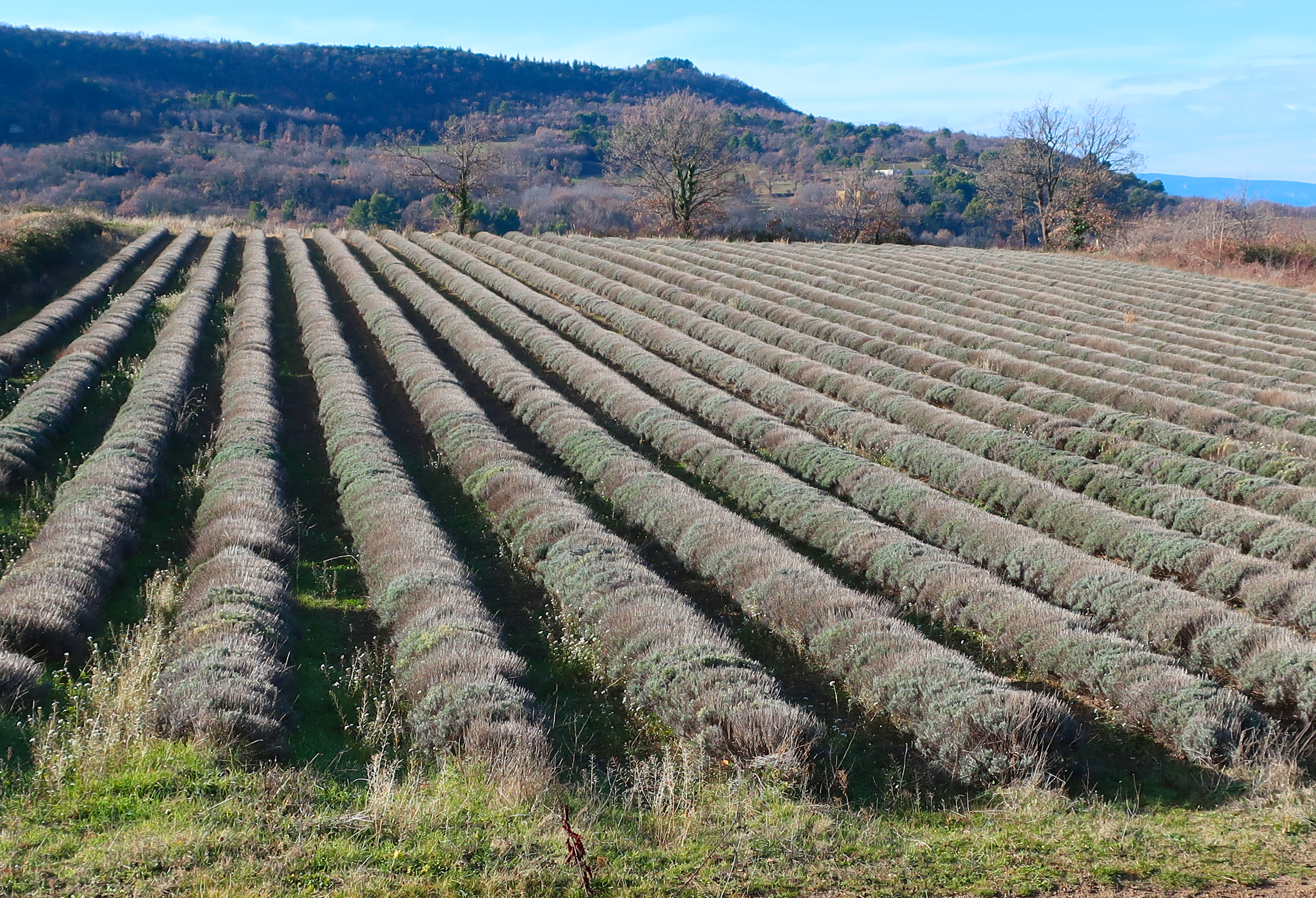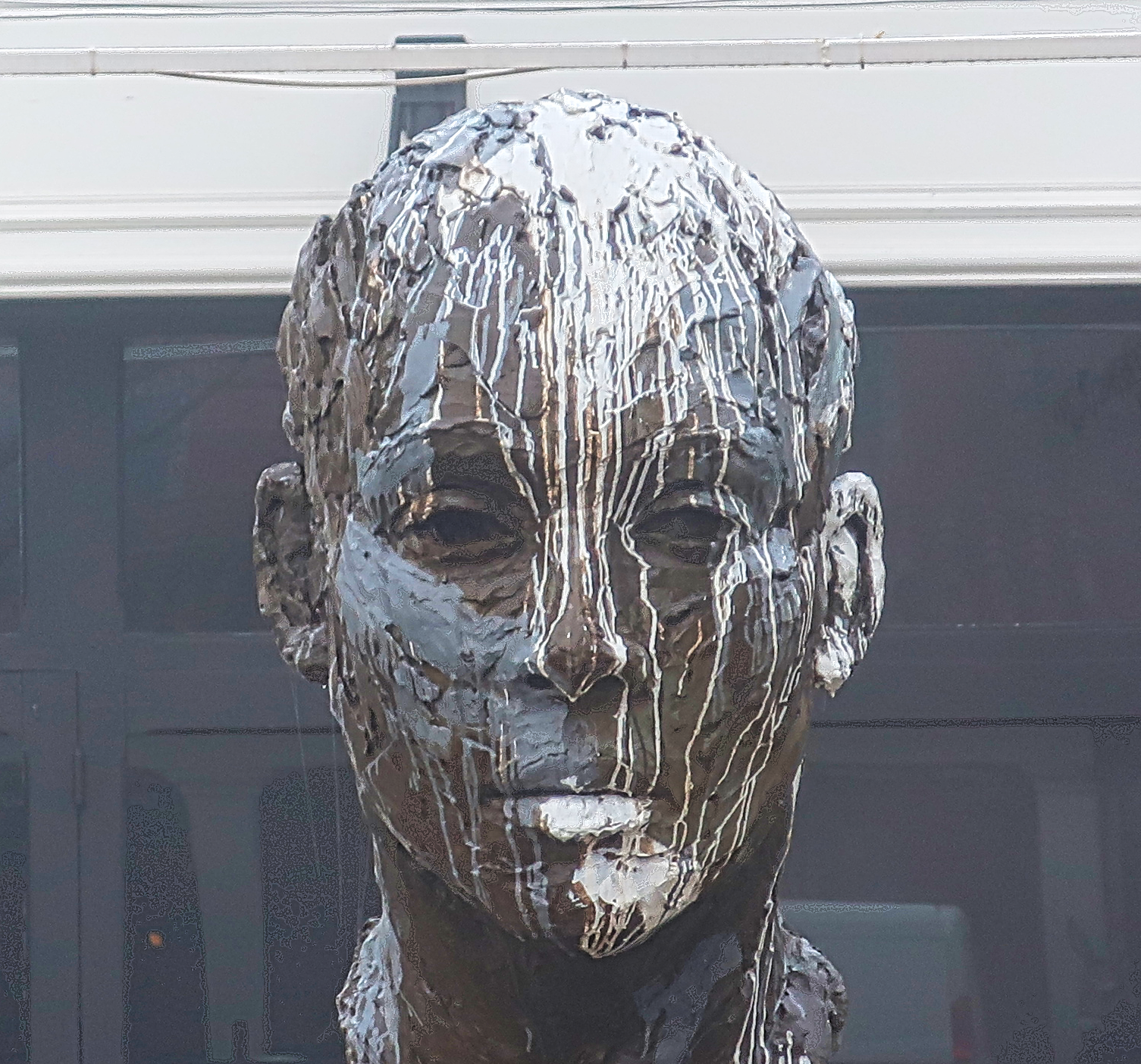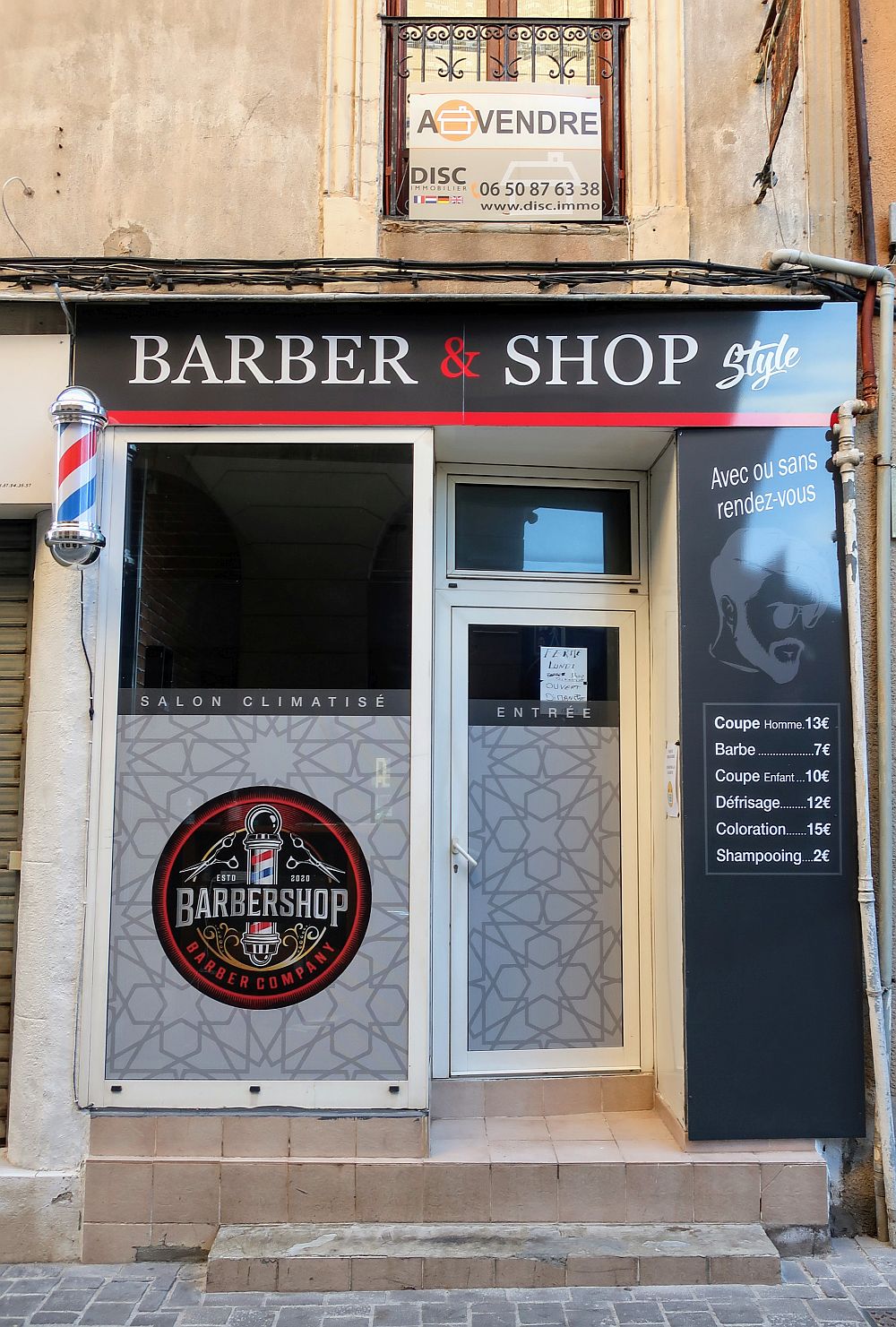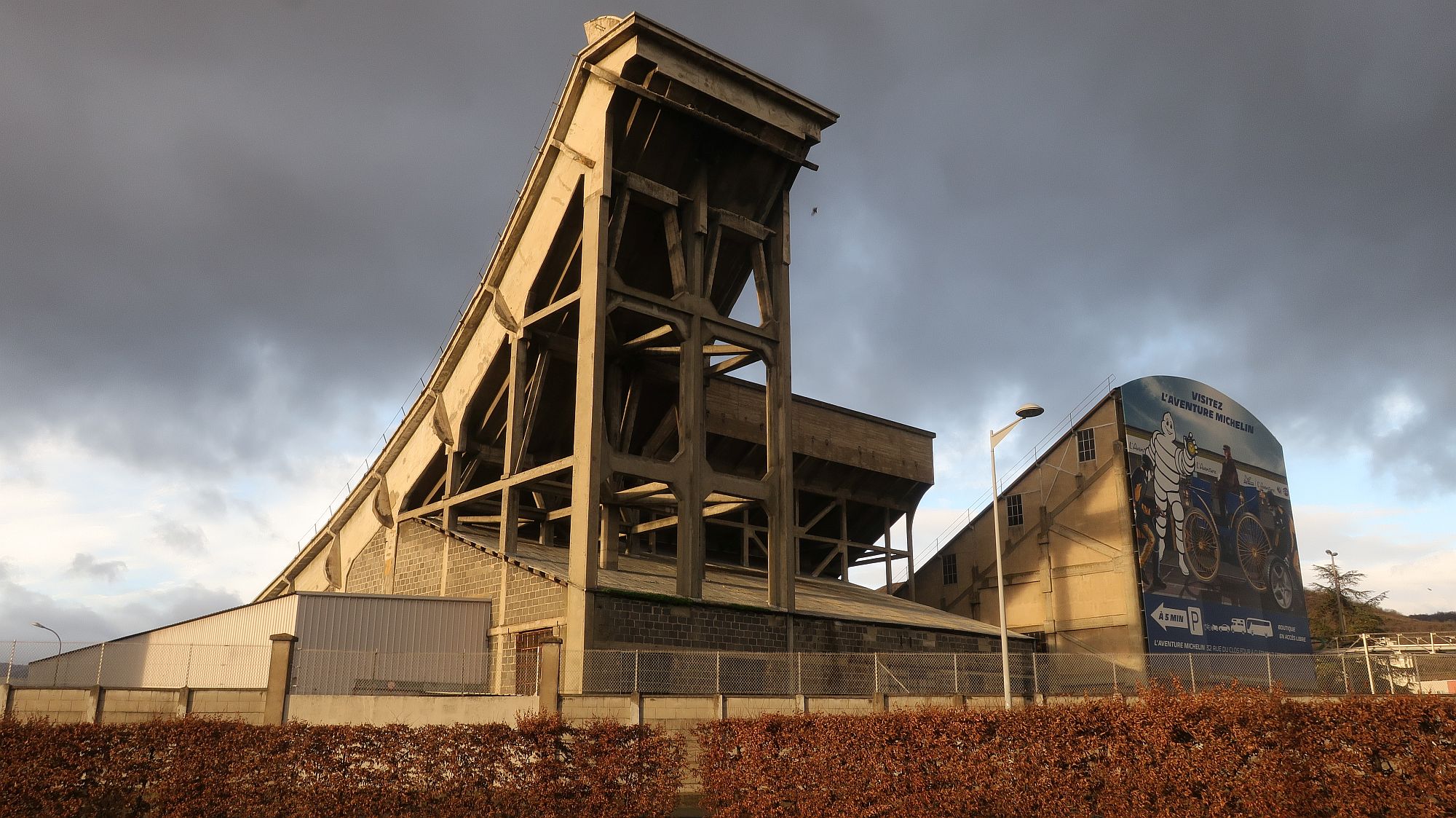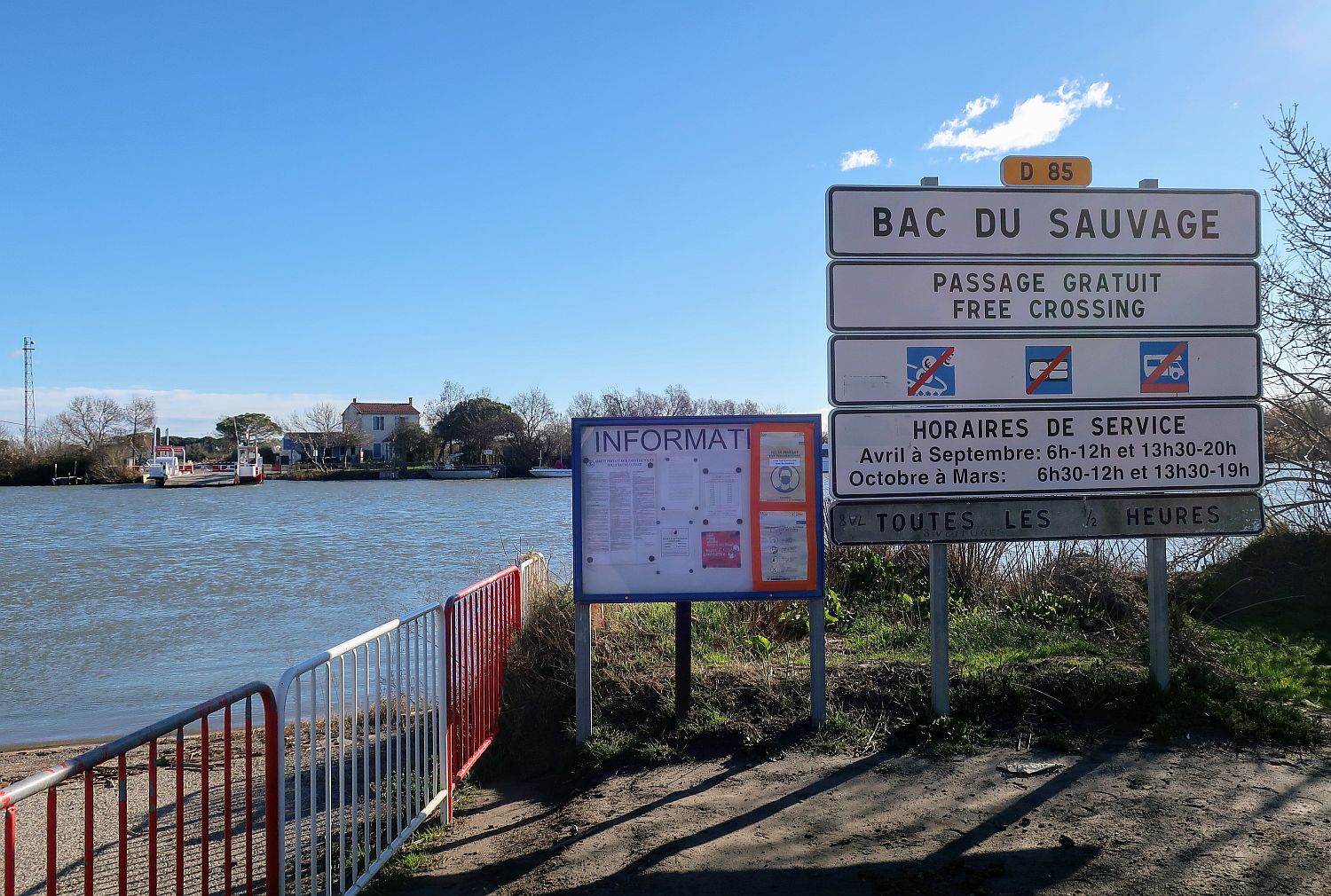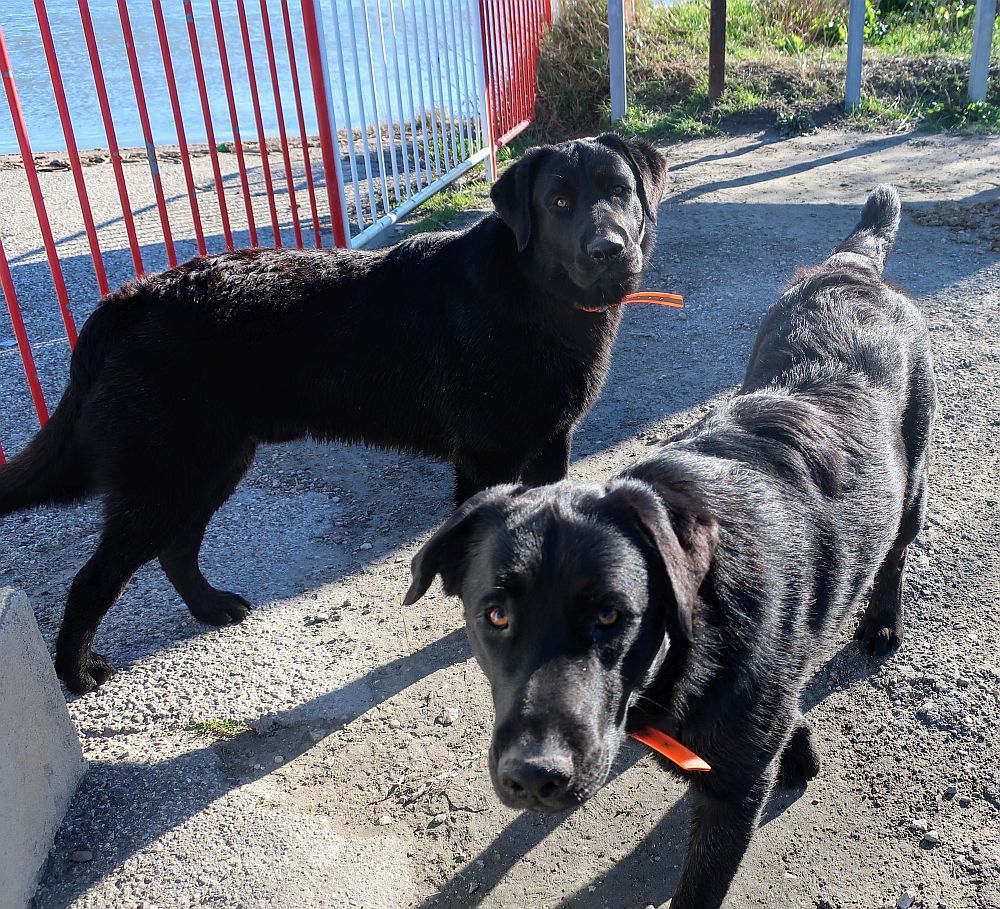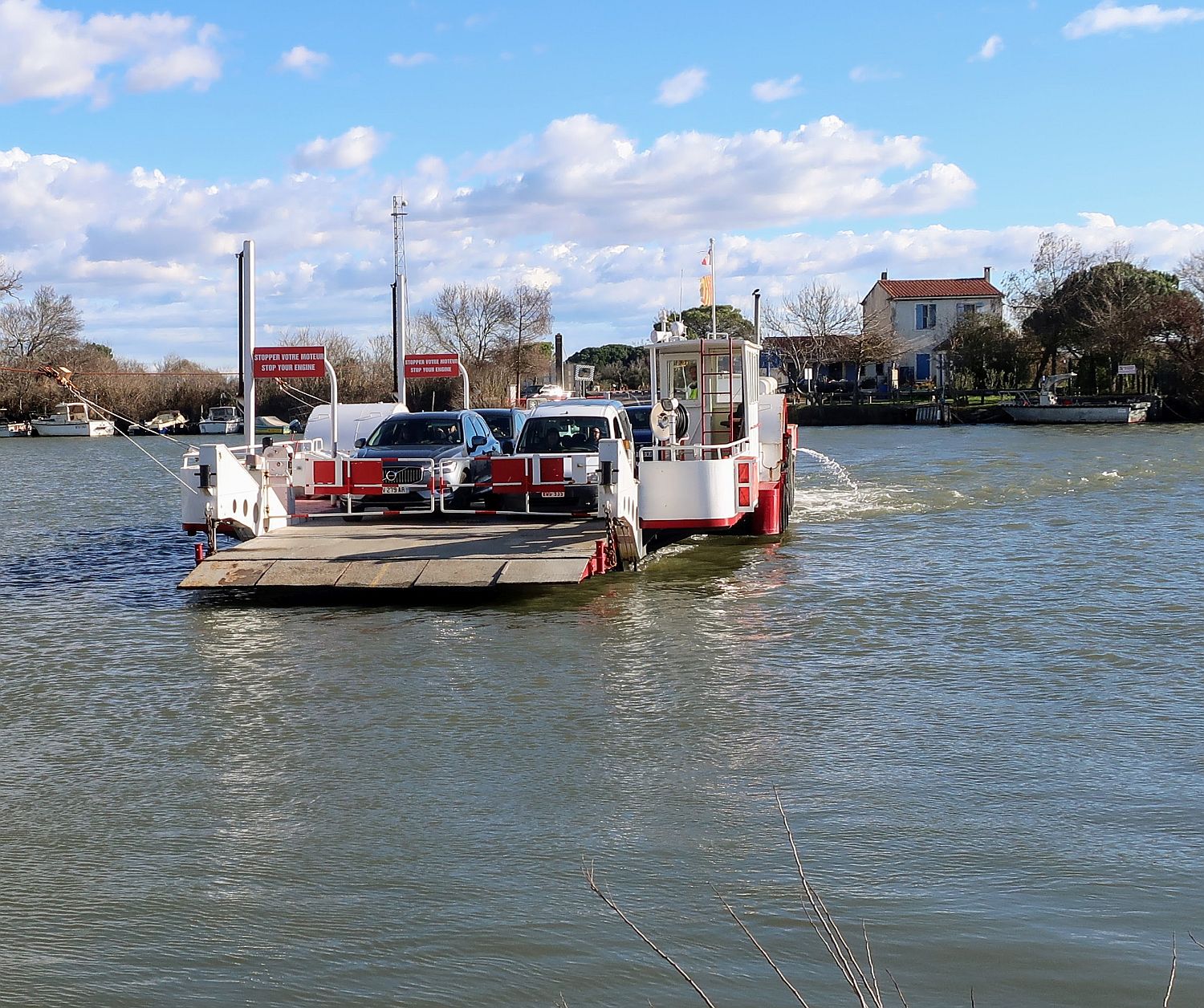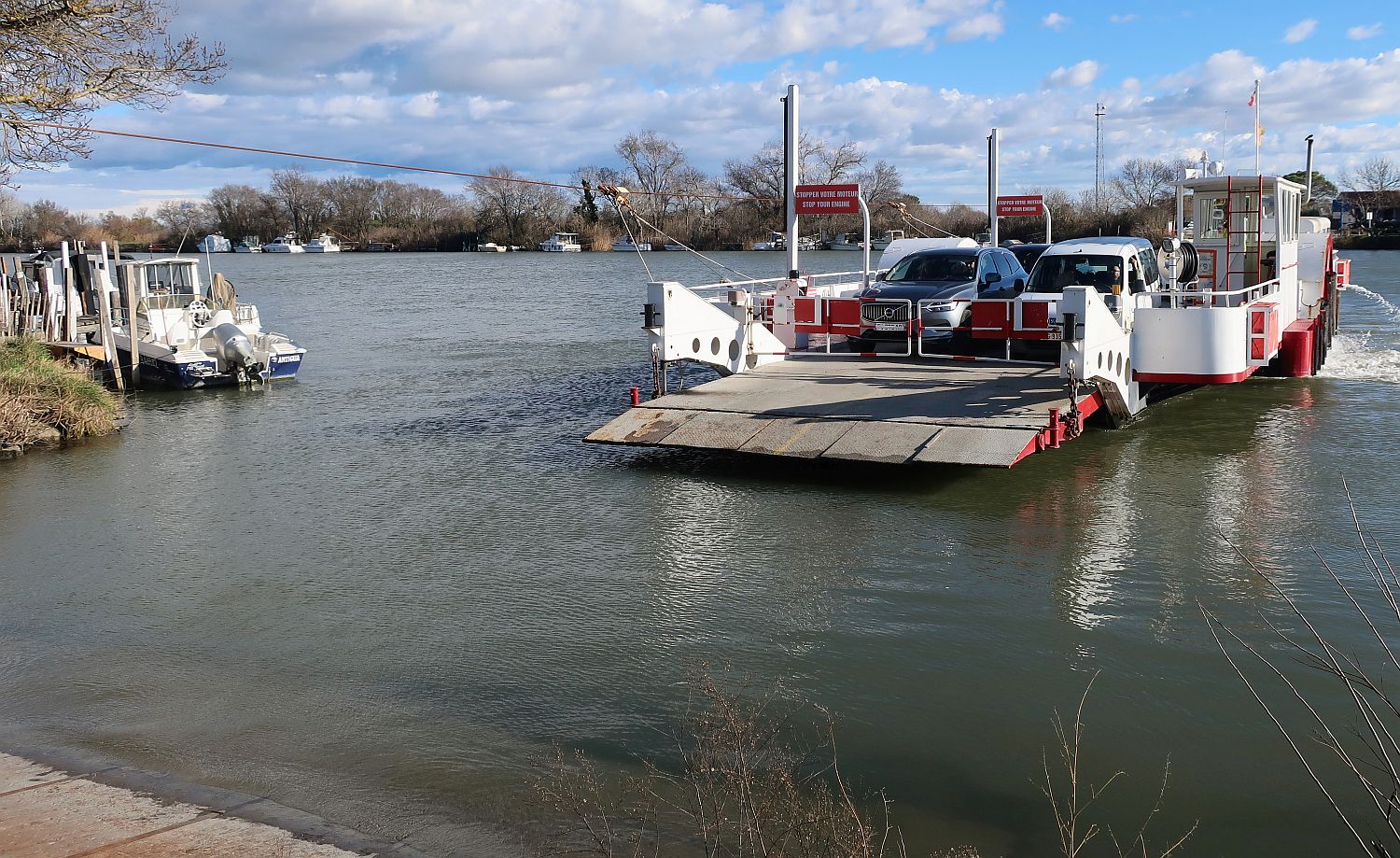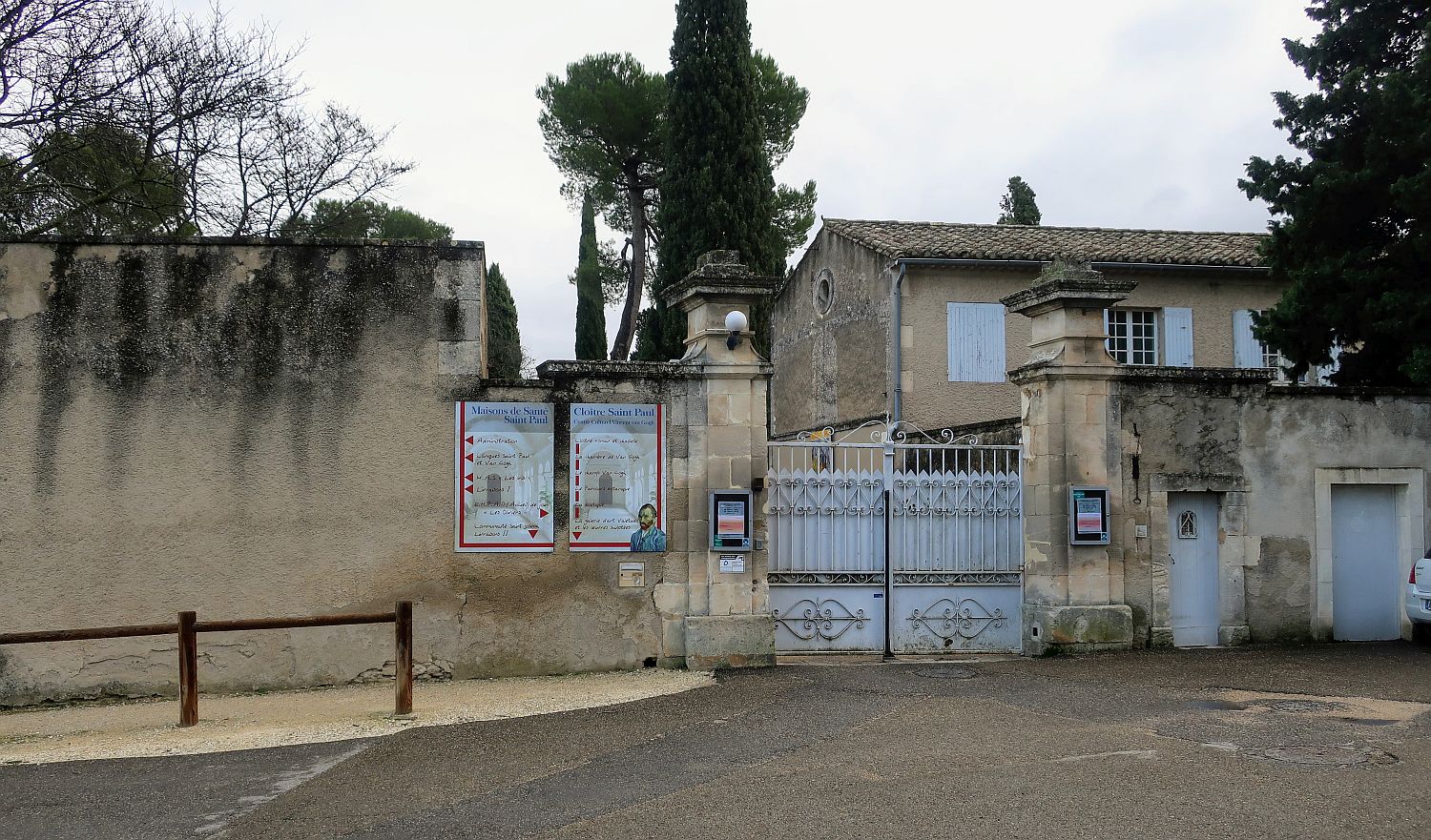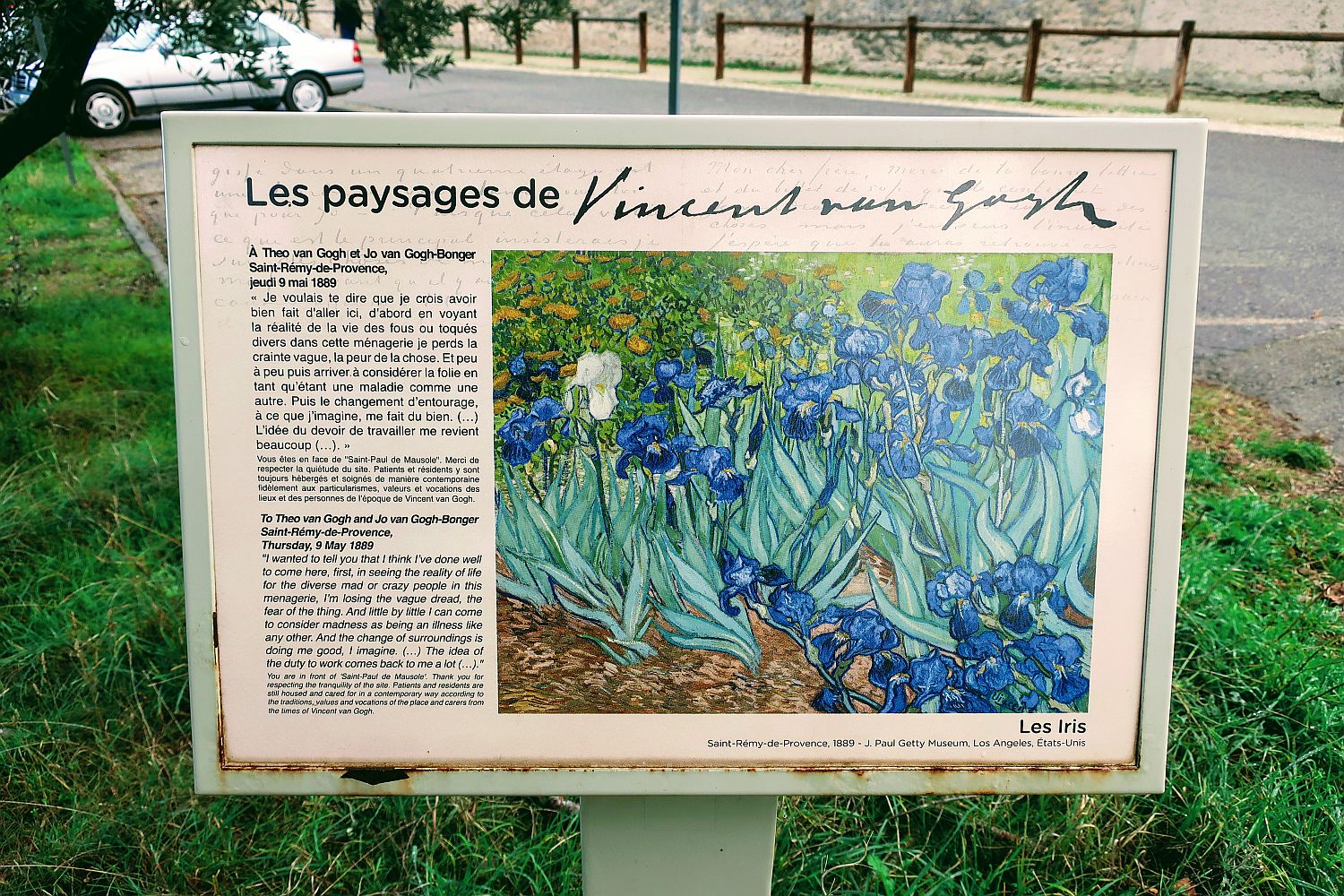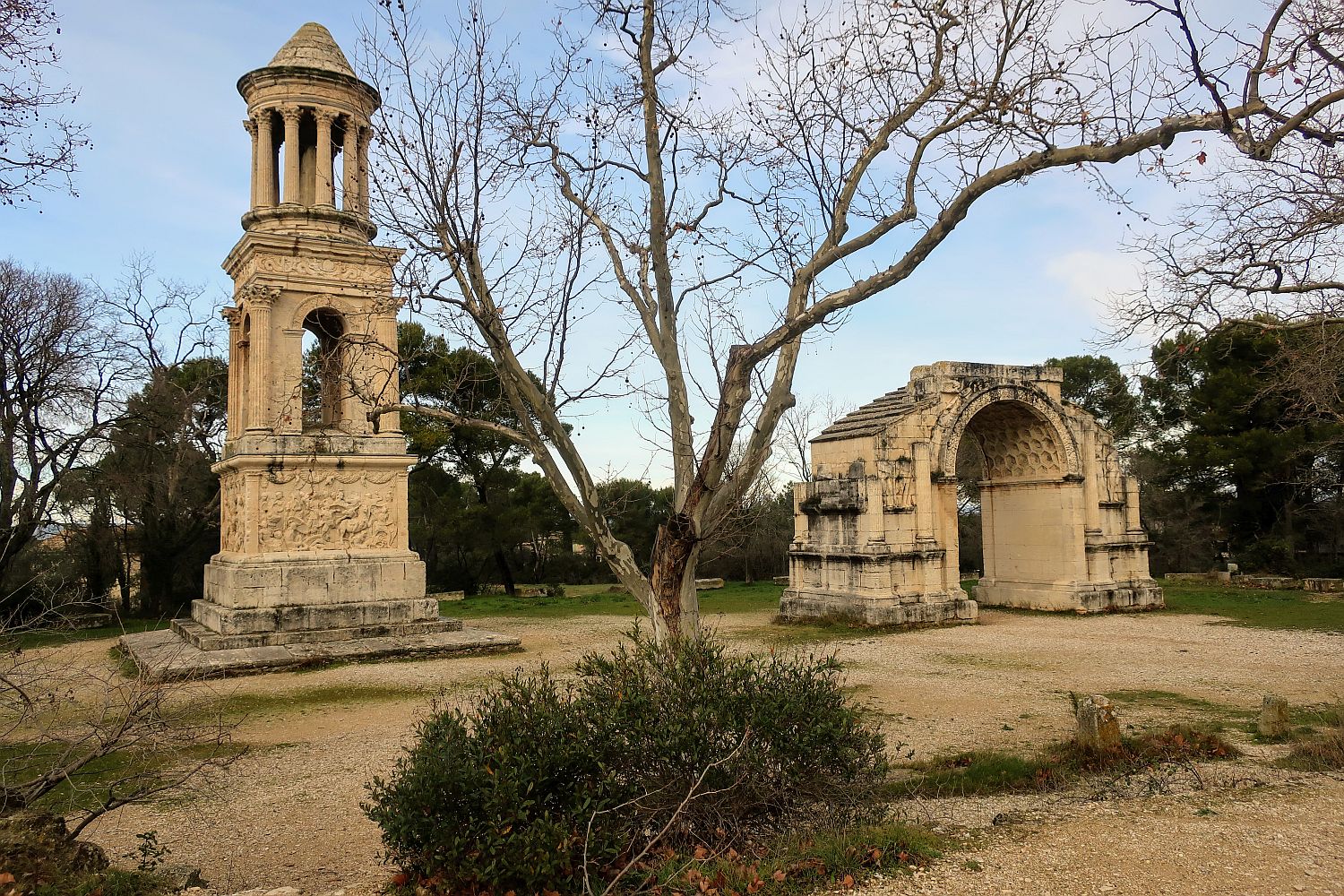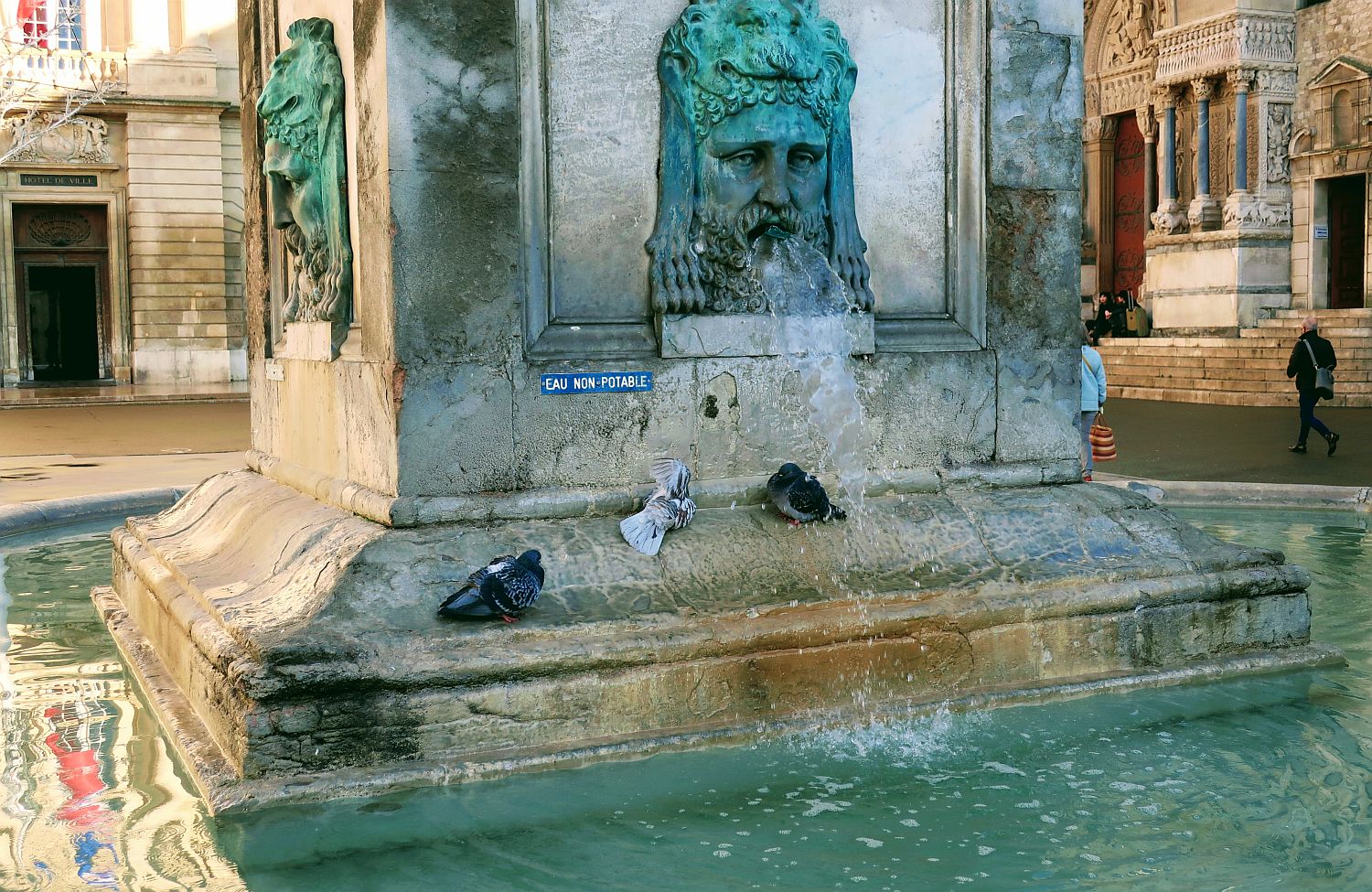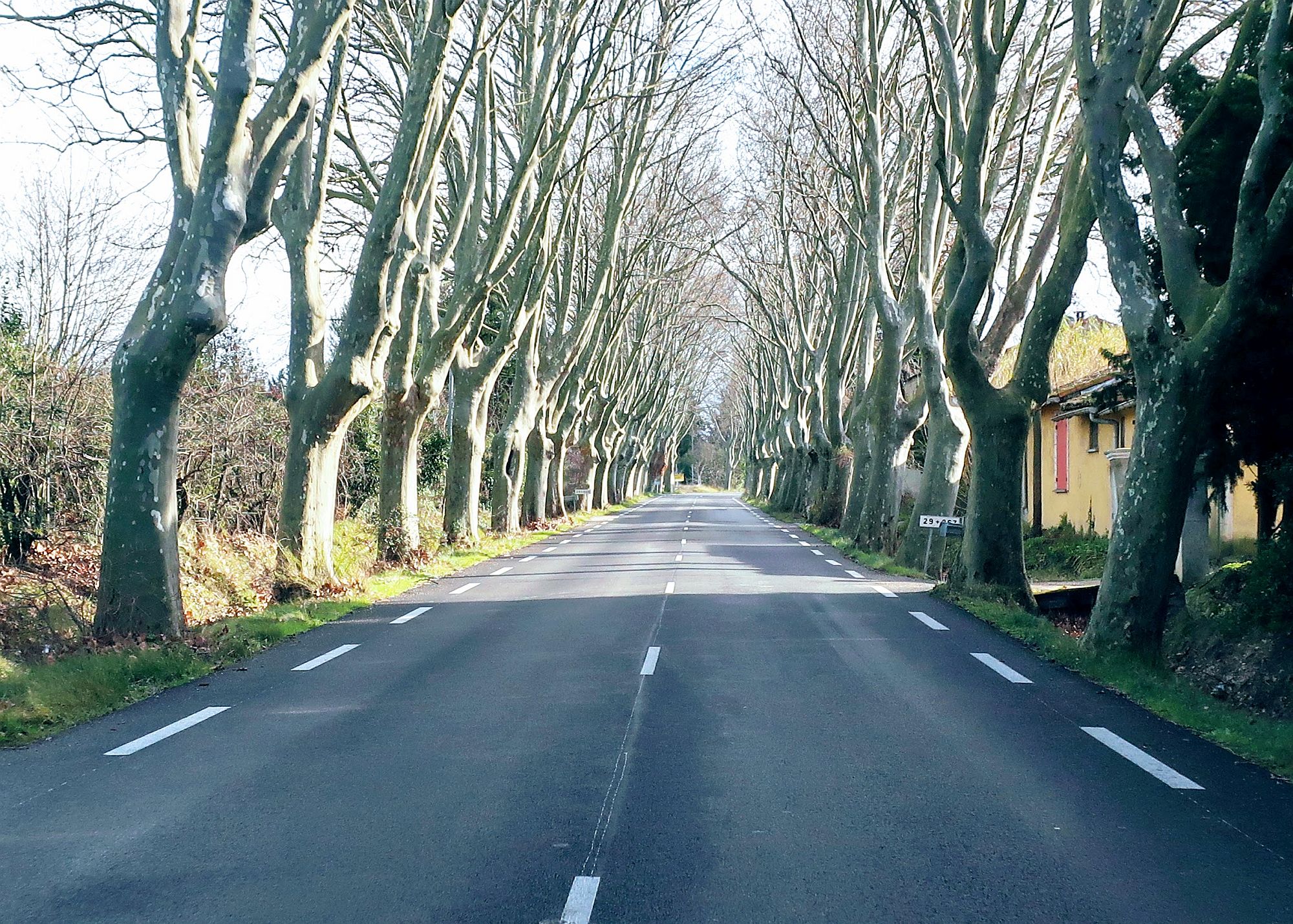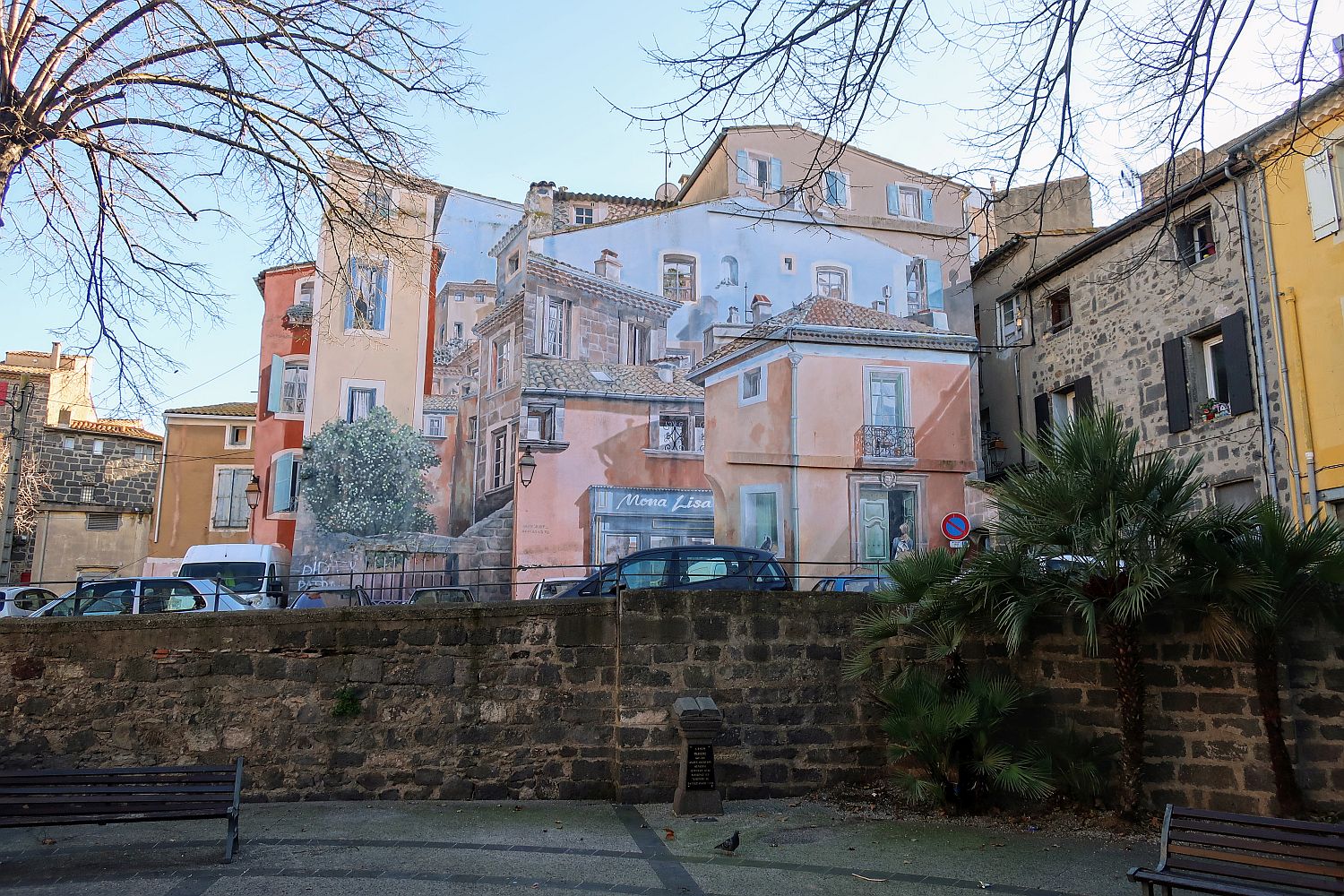Continuing the series, this is the village of Roussillon in the French Provence, famous for its ochre industry:
Provence
Fountain bull in Nice
Big Chicken in Nice
Pan Bagnat in Nice
Imagine an unbelievable sandwich sent to us from Heaven by St. Michael himself, a sandwich so mind-blowingly good that it’s dripping with tuna and anchovy happiness that makes your mouth simultaneously water and explode the moment you bite into it!
Such a sandwich was what I was hoping for . . . but sadly, this sandwich is not it:
The sandwich is called a Pan Bagnat – that doesn’t sound French, so my guess is that it could be a vestige of the Nicois dialect or even Langue d’Oc that is still occasionally spoken in the south of France.
I even tried eating it next to a French police cruiser to see if that would enhance the effect, but sadly the sandwich was not what I had hoped.
Roussillon countryside
Continuing the series,
Cavaillon pidgeon
A lone pidgeon sits on a fountain in the French Provence city of Cavaillon, and he thinks about his options. He’s not that dirty – but he does feel a bit dirty. And it’s not that cold – but it is somewhat cold. I saw him sitting here, thinking, for a long time. He ultimately had more patience than I, and I walked away before seeing if he took a bath.
Waterwheel in the fog
Saturn over Roussillon
Harvested lavender in Apt
I took this snap just outside of a lavender distillery in Apt,
I usually travel to Provence in the winter, then the lavender has already been harvested – it is on my bucket list to return someday and see how they actually harvest this plant. Judging from the neat shape of the hedges above, I assume they use some type of curved, bladed harvesting device.
Spent lavender in Apt
I took this snap just outside of a lavender distillery, in Apt:
Well, I can’t say it surprised me, but when I went up to the stuff and stuck my hands in and pulled out a huge amount and put it up to my nose and smelled it – no smell at all! Not only no lavender smell, but also no rotting smell. My guess is that if they subject the lavender leaves to high temperatures then this more or less sterilizes the organics, and it probably takes a while before bacterial action sets in and it begins to compost.
L’isle-sur-la-Sorgue shack
Continuing the series, I took this snap just outside of L’isle-sur-la-Sorgue, heading in the direction of Apt,
L’isle-sur-la-Sorgue Head
I captured this head just along one of the banks of mighty Sorgue river and it passed through the L’isle-sur-la-Sorgue,
Helical doorway in Arles
Arles Barber
Barbershop poles are interesting things. They have them in the US, of course. Germany doesn’t seem to have them – at least, I’ve never seen one in Germany. They are quite common in Switzerland.
And you can find them in France, but not everywhere.
I took this snap in Arles:
Of course it is probably more at home here in Europe, originally deriving from a sign used for shops that had doctors and leaches and were willing to bleed you with them.
But that begs the question: what else do we see in our daily lives and take for granted, but that we would have also seen hundreds of years ago? Probably if we could travel back in time there are more than a few things that we would instantly recognize.
Michelin test facility in the sunlight – 2
Continuing the series, here is another snap of what I thought looked magnificent in the winter sunlight:
Incredible, amazing, mind-blowing cable ferry
I’ve written about cable ferries before, such as the cable ferry on the Rhine.
My hobby is very dangerous in and of itself, visiting to the most secluded regions of France – regions so remote and backwards that it is rumored, the local inhabitants themselves (after centuries of in-breeding) often have no names.
The Gendarmarie cannot stop you – but if you ask their advice they caution strongly against it, pointing you back to the nearest McDonald’s restaurant.
But I like to throw caution to the wind, and despite the obvious dangers I set out to explore the delta where the Rhone River meets the Mediterranean Sea. Even today I’m one of the few Americans to have ever seen where the Mississippi River meets the Gulf of Mexico – that place, too, is better avoided by most tourists.
When driving to reach the secluded southern French village of Sainte-Marie-sur-la-Mer, the first thing you run across is a river and this sign:
Then next thing that happens: you step out of your vehicle and – suddenly! frightfully! just as you open your car door! – you are viciously attacked by two immense and deadly guard dogs:
Sharp fangs. Massive jaws to crush their prey. A growl that could scare Satan himself. It’s doubtful that these hounds of hell would allow many tourists to live.
If these vicious attack dogs do in fact let you live – and in my case thankfully they did – then you’ll come to realize that the road has ended, and there is no bridge to the other side. The river you see here is the Le Petit Rhone, an offshoot of a huge French river that transports the glacial water from Switzerland down through France and into the Mediterranean Sea.
Hmmmmm, you think to yourself. I am way over here. I want to be way over there.
That’s not just one but two “way overs.”
Hmmmmm, you think some more. Does my car float? No.
So you think some more. Hmmmmm. (That’s the sound of you thinking.)
But there is in fact a ferry, as you can see on the left side of the above snap. And slowly . . . in a matter of minutes . . . it dawns on you: Hey, I bet that ferry is no coincidence! Someone must have put that way over here so that I could travel way over there. My problem of two “way overs” is solved!
I had to wait for over an hour (it was lunch time, and the French are very serious about their lunches, very carefully timing them to include finishing the glass of wine and smoking a cigarette), but eventually the ferry was loaded up and started on its way over:
And here’s a snap just as it reached the shore:
The difference between this ferry and the one in the link I posted: that ferry is attached to a steel cable, and the steel cable provides the locomotive force that pulls the ferry across the Rhine. In this case there is also a steel cable as you can see in the snap above, but the ferry has a motor and the cable is used to guide the ferry.
How did the story end?
I left the vicious hounds of hell (that interestingly liked having their ears scratched), got into my car, drove onto the ferry, crossed the river, and headed towards my fate in Sainte-Marie-de-la-Mer, a place so remote that the locals (after centuries of in-breeding) have no names and do not tolerate tourists lightly.
Vincent stayed here (Monastery Saint-Paul de Mausole)
Site Archéologique de Glanum
Vincent van Gough put the tiny French commune of St. Remy de Provence on the map, since this is where he stayed in a hospital. Just a stone’s throw from that hospital (literally, across the street!) is a pretty impressive site of ancient ruins, called Site Archéologique de Glanum. There are many more ruins than shown here – these are just the most impressive ones next to the parking lot:
Birds keeping themselves cleaned and well-groomed in Arles
Une juxtaposition de protections à Arles – à trois!
This snap really appeals to me.
It’s a juxtaposition of protection in the southern French village of Arles. In the foreground, modern protection against Covid; in the background, medieval protection against lawless threats. And on the side, that column you see is the sensor for a bollard, a modern traffic barricade that helps keep the inner city streets free from the threat of terrorists using their vehicles as weapons.
All three things serving a very similar purpose, keeping out something that is unwanted.
The amazing white horses of Provence
The Camargue region in southern France (essentially the swampy delta where the Rhone River empties into the Mediterranean Sea) is famous for its white horses, which many scientists actually think are one of the oldest breeds of horses in the world.
I took this snap down a deserted road in the Camargue, just outside of Sainte-Marie-de-Mer in the south of France
Cement in Beaucaire
More plane trees in Beaucaire
Plane trees in Beaucaire
There are many good things about France that trace their origin back to Napolean – and the zillions of kilometers of streets in the south of France, lined by plane trees carefully planted to give shade to army troops, is one of them.
Here is as artistic a snap as I thought I could take of a street in the southern French village of Beaucaire, lined with plane trees:
If you think they are all leaning to the right, you’d be right. This part of France lives under the so-called Mistral wind, a wind of up to nearly 75 km/hr that forces trees to grow tilted. I visited in the winter, and there were numerous times I had to stop the Euro Cruiser, my minivan, because the wind gusts were too strong to safely drive.
An optical illusion in Agde
Continuing the series, here is a snap from the Southern French village of Agde,
